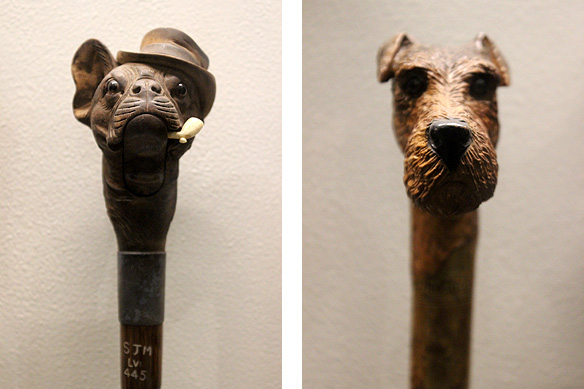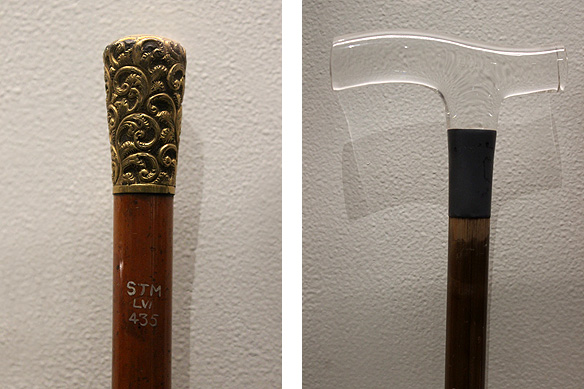
Have you ever been to a museum gallery dedicated to just walking sticks? Yup, you read me right—walking sticks. In all shapes and sizes, in cane, Malacca cane, wood, sandalwood, ivory, fish-bone, jade, glass, metal, and leather. Walking sticks with snuff boxes, and umbrellas and gupti [blades] inside. Where some handle heads are decorated with semi-precious stones, some lined with silver and gold, and others yet shaped as horse hooves, shoes, classical figurines, and the various inmates of an animal farm.
Bet you have not! 😀
When I walked into the Salar Jung Museum in Hyderabad’s Old City I was prepared to be boggled by its collections. Everyone I met here insisted I visit it. They warned me I needed to spend a few hours at least in its galleries and that too would only scratch the surface.
The museum has the inevitable Indian sections covering bronzes, sculptures, textiles, ivory, arms and armoury, jade, bidri art [native to Hyderabad], minor arts, and miniature and modern painting. It is, however, more renowned for its European collections which fill countless galleries with paintings, porcelain, glass, bronzes, marble statuary, furniture, and clocks from the continent. Meanwhile, a sizeable number of Persian carpets and manuscripts, Egyptian and Syrian art, as well as Sino-Japanese paintings and carvings add to the museum’s eclectic nature.
What is most extraordinary though, more than all of the above, is that this humongous melange was collected by One.Single.Person: A 25-year-old who went by the name Nawab Mir Yusuf Ali Khan Salar Jung III (1889–1949). The former Prime Minister of the 7th Nizam of Hyderabad, Salar Jung III gave up his cushy job after merely two years in office to spend the rest of his life travelling the world.
Armed with his inheritance, he visited 44 countries and collected over 42,000 art objects, 9,000 manuscripts and 60,000 books, adding substantially to a collection started by his grandfather. He died a bachelor; his legacy bequeathed to the Indian government in 1958.
Salar Jung III was the last and 33rd descendant of an influential Hyderabadi family who traced itself back to Shaik Owais Qarni, a religious head in Medina. Qarni immigrated to India in 1656 in search of better fortunes. Over time the family became the hereditary prime ministers to the Hyderabad State’s rulers, the Nizams.
With 38 galleries spanning major cultural blocs from the 2nd Century BC to the 20th Century AD and displaying 13,654 objects, the museum holds pride of place in Hyderabad. Highlights include, amongst others, the “Veiled Rebecca” from Rome, a set of ivory chairs presented by Louis XVI of France to Tippu Sultan of Mysore, and a jade fruit knife encrusted with precious stones which once belonged to Nur Jahan [the Mughal emperor Jahangir’s favourite wife].
Amidst these resplendent artefacts stands the Walking Sticks Gallery with its compilation of about 250 pieces from the Jung family’s private collection. And in my opinion it is the most interesting gallery of all, for who would have thought an inane object such as a walking stick could come in so many exotic and innovative forms. Browse through the images, and you will see what I mean. 🙂

Walking sticks operated by buttons for curiosity: There is a button behind the skull which when pressed makes the skull open its jaw.

Walking sticks with ivory heads carved and chiselled to form animal heads …

… and tigers eating their prey, and elephants eating lions.

Walking sticks with wooden heads of dogs; their eyes are made of glass.

Walking sticks with mother-of-pearl heads shaped like axes and birds.

Some more ivory, but this time classical and discrete with minimalist designs.


Walking sticks in gold and glass.


These were made to look like golf clubs and double up as snuff boxes. The semi-nude figurine is evocative of classical themes.

Where there is ivory, hand painted porcelain is not far behind.

Walking sticks shaped like footwear, replete with the polished look and feel.

Time to visit the animal farm all the way from Europe.

Last but not least, notice the exquisite craftsmanship of these carved heads in ivory and wood—the beauty is often in the details.

Left: The Walking Sticks Gallery has on display about 250 walking sticks; Right: Salar Jung III, the collector himself.
Travel tips:
- Address: Salar Jung Museum, Salar Jung Road, Hyderabad, Telangana – 500002; Tel: +91 40 2457 6443/ 2452 3211; Email: salarjungmuseum@gmail.com.
- Timing: 10:00 am – 4:30 pm [Closed on Fridays and Public Holidays].
- Ticket: Rs. 20 for Indians; Rs. 500 for foreigners.
- Audio guide: Rs. 60; Guides are also available at Rs. 300 for an hour-long walk of the highlights after which you could browse on your own. My guide was Rajendra Prasad. He was excellent and can be contacted at +91 98 6641 2881/ 80 7473 7690.
- Photography charges: Rs. 50.
– – –
[This post is a re-post. It was first published on ramaary.blog on 13 July, 2017. Due to COVID 19 restrictions, I am unable to generate new travel content. In its place I am reposting some of my favourite posts which I had blogged about earlier.]

niche + museum = nichzeum?
so random and yet so amazing
LikeLiked by 1 person
Haha, love the word nichzeum! 😀 It is so spot on. And I also love the random/ amazing phrase. You couldn’t have described my experience better. 🙂
LikeLiked by 1 person
Answering your question, yes, I’ve been to this gallery! Salar Jung museum is the reason I would like to come back to Hyderabad – spending three hours among its treasures was way too little! There were so may lovely things to discover – this gallery of walking sticks, the double statue of Mephistopheles and Margaretta, all the paintings and ceramic objects, Veiled Rebecca, of course, and so much more. Hard to believe it’s a one man collection. Hope to spend the whole day in this museum when/if I make my way to Hyderabad once again. Thanks a lot for the interesting post and bringing back pleasant memories.
LikeLiked by 1 person
Woow
LikeLiked by 1 person
So lovely to hear from another museum lover, and that too one who was equally enamoured by the gallery! Yeah, three hours is not enough and the museum is reason enough to revisit Hyderabad. 🙂
LikeLike
Amazing
LikeLiked by 1 person
Glad you enjoyed the post. 🙂
LikeLiked by 1 person
🌲
LikeLike
Pingback: 36 hours in hyderabad old city | rama arya's blog
Waoo. Just curious if they were for everyday use who would use them ?
LikeLiked by 1 person
Salar Jung III, who is responsible for most of the collection, liked his walking sticks. The quirkier it was, the more attractive it was to use and show off, I guess. Extreme wealth brings with it, it’s fair share of idiosyncratic tastes. 🙂
LikeLike
Sounds cool
LikeLike
Certainly one of its kind. I visited this museum when I was a kid and all I remember is the marble statue of a lady in the veil. I’m sure you must have seen that it is definitely one of its kind.
LikeLiked by 1 person
Aah, the Veiled Rebecca! Yes, I got to see it. 🙂 An absolute masterpiece. I have written about it as well.
LikeLiked by 1 person
I can’t recall the name since this trip took place many many years ago! I can’t recall this in your blog….my memory is to be blamed!
LikeLike
By collecting so many objects, Jung ultimately provided an enormous public service. Who knows how many people have enjoyed and/or been inspired by his collection. Millions, probably.
LikeLiked by 1 person
That’s a wonderful thought! And so very true. I love the way you see everything with fresh eyes — a perspective which comes out beautifully in every single post of yours as well.
LikeLiked by 1 person
This is so interesting
LikeLiked by 1 person
Yup, it is a fascinating collection, isn’t it. The gallery was easily one of the most charming ones I have visited in my travels. 🙂
LikeLike
Didn’t knew so much of collection to this.. Thank You for the Share..
LikeLiked by 1 person
I am happy you enjoyed the post, Kovai. Thank you for sharing your thoughts on it. 🙂
LikeLike
What an exquisite collection! This man really has style 🙂 My favourite is the rabbit cane. It somehow reminds me of Alice in Wonderland haha.
LikeLiked by 1 person
Haha. What can I say? You have great taste. 🙂 But seriously, I was floored when I saw the collection as well. The exhibits took the humble walking stick to a completely new exalted level!
LikeLiked by 1 person
Pingback: 36 hours in hyderabad old city | rama arya's blog
Pingback: art focus – three dimensions of divinity – thanjavur art revealed | rama toshi arya's blog